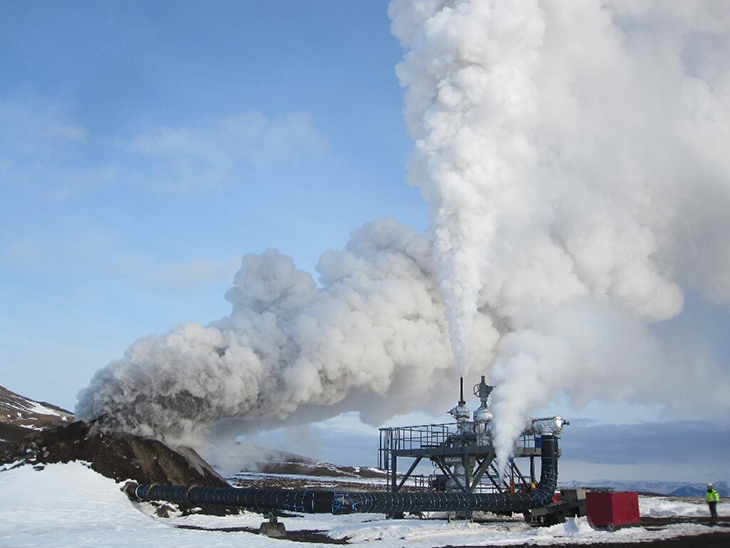
The remote Icelandic locale known as the Krafla Magma Testbed (KMT) has captured the imagination of scientists worldwide as a potential epicenter for groundbreaking research in volcanology. Nestled amidst the rugged terrain lies a geological marvel—a “magma well” that promises to revolutionize our understanding of volcanic activity and energy extraction.
At the heart of this geological wonderland stands the world’s first magma observatory, the Krafla Magma Testbed. Its inception marks a pivotal moment in scientific exploration, offering a unique vantage point into the dynamics of subterranean magma chambers. This pioneering facility holds the promise of catalyzing transformative breakthroughs not only in volcanology but also in the realm of geothermal energy technology.
The primary aspiration behind the establishment of the Krafla Magma Testbed is to enable direct observation and recording of magma beneath the Earth’s crust—a feat never before accomplished. Unlike previous endeavors marred by limitations and makeshift solutions, the KMT provides an unprecedented opportunity to study molten rock in its natural habitat. Situated perilously close to the Earth’s surface, the magma reservoirs beneath the KMT offer a rare window into the inner workings of our planet.
The genesis of the Krafla Magma Testbed traces back to 2009 when the Icelandic state-owned geothermal energy company, Landsvirkjun, embarked on a quest to harness the untapped potential of supercritical water reservoirs above magma flows. Their ambitious endeavor, part of the Icelandic Deep Drilling Project, sought to penetrate the Earth’s crust to a depth of approximately 5,000 meters. However, their aspirations encountered an unexpected twist within the confines of the remote Krafla Caldera.
At a mere depth of 2,100 meters, the drilling operation unearthed a startling revelation—far removed from the anticipated supercritical water reservoirs. Instead, the probing instruments encountered the pulsating heartbeat of molten rock, signaling a deviation from the expected geological strata. This serendipitous discovery laid the foundation for the birth of the Krafla Magma Testbed, igniting a new era of scientific inquiry and exploration in the realm of volcanology and geothermal energy extraction.
“We were unable to retrieve the whole thing, but a section of the drill string that was freed was filled with fragments of freshly quenched glass. When that happens it’s clear we have penetrated magma,” said Sveinbjorn Holgeirsson in a 2015 video documentary. He is the project manager for Landsvirkjun.
Krafla stands out as an unparalleled geological phenomenon due to the unprecedented proximity of magma to the Earth’s surface. This rarity presents a singular chance for researchers, offering an opportunity that may not arise again in their careers.
Currently, significant financial support from the International Continental Scientific Drilling Program, supplemented by substantial contributions from Icelandic and EU governmental initiatives, has propelled the Krafla Magma Testbed (KMT) into a pivotal testing phase. This phase aims to assess the viability of establishing a sustainable, long-term magma observatory in the region.
“What we know about magma comes from interpreting activity measured at the surface, the geology of fossil magma chambers, and laboratory experiments. The Krafla drilling project will provide direct samples and observations, helping the world to read signs of volcanic unrest better,” University of Alaska Volcanologist John Eichelberger said.
“It will improve civil protection for the 800 million people who live within 100km of an active volcano: be they the millions of Indonesian citizens living under the veil of the archipelago‘s active volcanoes or the millions of tourists visiting America‘s Yellowstone National Park.”
The challenges posed by highly corrosive gas and superheated steam at temperatures reaching 450°C are formidable, but the potential rewards are vast. Take, for instance, the generation of 13 megawatts of geothermal energy, capable of powering approximately 60,000 homes, all derived from just 2 boreholes positioned strategically over the magma well. This achievement stands in stark contrast to the necessity for 18 boreholes in similar geothermal ventures elsewhere on the island.
Unlocking such energy potential hinges upon the ability to drill into magma chambers, which typically elude conventional drilling equipment. However, by pioneering techniques to penetrate the rock-magma interface and access magma, the KMT (Kilauea Magma Tracking) initiative can not only harness geothermal energy but also gain unprecedented insights into the dynamics of magma storage beneath volcanoes. Through controlled fluid injection, scientists can monitor reactions within magma chambers, validating various scientific hypotheses. Moreover, the deployment of sensors in close proximity to magma promises direct measurements of critical parameters such as temperature fluctuations, crystallization patterns, gas composition shifts, and pressure variations indicative of potential eruption risks.
Contrary to popular perception, magma isn’t simply a bubbling pool of lava underground; rather, it manifests as fluid-filled pockets weaving through crystalline structures, enveloped by intensely hot gases.
To surmount the extreme conditions encountered during magma exploration, KMT’s partners are actively developing specialized materials, including heat-resistant steel capable of withstanding temperatures exceeding 1,000°C, and robust electronics engineered to endure harsh environments. Such advancements not only facilitate terrestrial exploration but also pave the way for future missions to explore celestial bodies like Venus, as noted by Paul Voolsen in a publication called Science.
Recent updates on the project timeline have earmarked 2026 for the commencement of initial drilling endeavors, marking a significant milestone in the pursuit of unlocking the potential of geothermal energy and advancing our understanding of volcanic processes.
What are your thoughts? Please comment below and share this news!
True Activist / Report a typo


